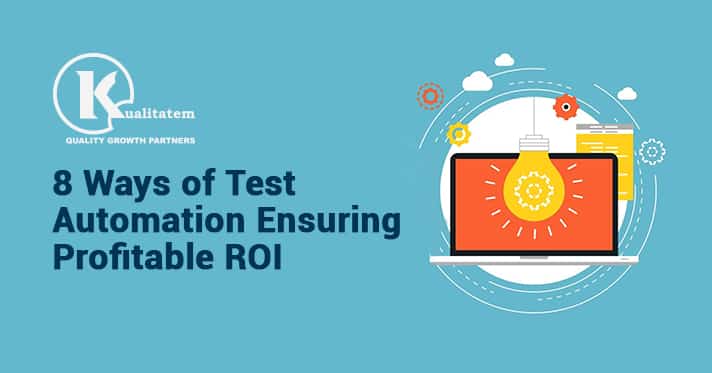8 Ways of Test Automation Ensuring Profitable ROI

- January 13, 2020
- HibaSulaiman
The technological advances and demands for faster release cycles are also emphasizing on improving software quality. Modern trends like automation testing, DevOps and, CI/CD approach have raised the bar by combining speed and quality in a Software Development Life Cycle (SDLC). To stay ahead of the competition, teams are looking for ways to optimize their software testing and development processes to achieve more in less time while keeping costs low.
Combining Speed, Quality and Low Cost to Achieve Business Goals
This fusion of cost, speed, and quality is the biggest challenge every QA team faces and strives to excel at. Previously, these teams had to tradeoff between these three factors. When teams focused on delivering faster, they faced higher bug risks in production. While trying to maintain quality, they had to compromise on the release date. By implementing test automation, they no longer need to choose. As enterprises look for an automation testing company to keep up their pace for faster and quality delivery cycles, it is crucial to assess whether the Return On Investment (ROI) is worth it, or not. Before executing a test automation strategy, testers should calculate the ROI enterprises expect to earn from automation testing.
Why Automation Testing?
Automation drives growth and follows manual testing. Test automation involves using software, to check the execution of tests and compare actual outcomes with the expected results. The key feature of automation is that it automates recurring and mandatory tasks by implementing testing tools. Therefore, businesses should accelerate and automate their testing processes to ensure quality products. The main purpose is to make effective use of automation testing to keep costs low and meet delivery schedules. With the increase in customer demands, enterprises need to develop applications within short timelines and it is simultaneously important to optimize the existing manual efforts.
Let’s have a look at the 8 ways of how test automation can ensure profitable ROI:
1. Decide What Needs to be Automated:
QA teams need to identify and decide which tests need to be automated. Lest they fail to do so, achieving their desired output won’t be possible. Thus, they should consider critical factors including test environment, hardware dependence, app under testing, etc. Testers can follow an approach that is risk-based to determine tests that require automation.
2. Prioritize the Tests:
After determining which tests should be automated, testers should prioritize and divide tests. It helps them in identifying desired outcomes with test automation. QA teams can manage complex tasks by setting priority levels, and divide tests to meet the timelines that they need to achieve. Here, QA managers should keep in mind that all team members do not have the same skills, thus they should draft new plans for new repetitive test cases.
3. Effective Automation Strategy:
Testers make a mistake when moving from manual to automation testing. They should not be looking for 100% coverage. It increases the automation costs, and chances are high that tests may require manual tests, which may not provide the expected results. So, testers should ensure they devise an effective automation strategy to achieve high ROI.
4. Test Case Preparation:
If you are a QA tester, make sure you identify the test cases and scenarios before beginning test automation. It allows testers in understanding the execution time for each test and identification of defects. Testers can identify application workflow to find out what can be automated. The right automation testing company helps teams to work at an accelerated speed to achieve quality products.
5. Create Automated Tests that Require Minimum Maintenance:
Typically, testers create tests and scripts based on certain keywords, that change with functional aspects and UI. In such cases, test scripts may not work with upgraded versions of the applications. Thus, testers should create tests in such a manner that it does not affect changes in the UI. In addition, tests should use unique names for various UI controls as it helps to ensure that the automated tests remain unaffected by changes in UI. It makes the automated tests work smoothly without any updates required.
6. Quality of Test Data:
If you are looking forward to building a successful automation strategy, make sure you ensure the quality of test data. Focus on the data size to optimize it with all the relevant details. QA teams can combine data into various categories including valid, invalid, etc. It is important to update the automated tests periodically to achieve accurate results. It also decreases the number of issues/defects appearing in a software application.
7. Setting-up Proper Testing Infrastructure:
QA teams should utilize tools, techniques, and frameworks that suit best for specific test scenarios and applications. Testers can use a combination of black-box testing, exploratory testing, white-box testing, etc. With the help of the right tools for reporting, bug tracking, etc. teams can achieve their desired outcomes.
8. Periodic Review and Maintenance of Tests:
It is important to review the test data periodically for the identification of test validity. Testers can sort out outdated and unnecessary tests and help reduce maintenance costs. It also has a long-term effect on the test automation project.
Enterprises can also observe an increase in their business’s ROI by keeping a keen eye on product evolution. Testers can utilize automation testing tools that consist of reusable test cases and plans, smaller test cases, etc. that assist in maintaining tests. Teams can keep their automation testing suite up-to-date for a long time period.
We understand that the shift from manual testing to test automation is not that simple. It can be challenging for enterprises to make this shift, but given the advantages, it brings along – firms are motivated to automate as cleverly as possible. An automation testing company helps businesses in ensuring profitable ROI by focusing on keeping costs low and improving speed and quality.











